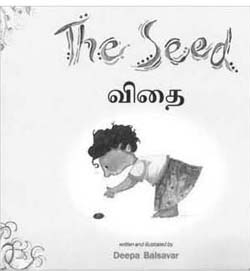I loved Deepa Balsavar’s The Seed the sec- ond I saw it. This little book about a girl who finds a seed and plants it, is so full of warmth and colour that it is impossible not to go back to it again and again. The words are simple—the sentences no more than three or four words long. Its protagonist, a small girl who looks about four years old, appears in a skirt and top with a curly mop of hair. She is immediately relatable and full of animation, buzzing through the pages with energy. One moment she is skipping, another moment she’s found a seed and is full of questions about it. The little girl’s curiosity about the seed takes her to the other members in her family—what do they think this seed will grow up to be? We don’t hear their answers. Perhaps the adults are too slow to respond to her questions (as they typically are!) and she must already bound to the next one! The assured first person voice—‘I found a seed. I put it in a pot’ and so on—is child-like, genuine and devoid of any cutesiness that adults imitating children often impose on their language.
The images of the trees in bright, surreal colours and textures make them come alive in the reader’s mind as creatures with a life of their own. There are plenty of children’s books that have a cat or a dog as a beloved pet but it isn’t so easy to create the same kind of bond and friendship between a child and a form of life that doesn’t move or respond in immediately perceptible ways. And yet, this is what Balsavar achieves. There’s no attempt to ‘humanize’ the plant in any way in the illustrations either—there are no toon eyes or expressions to show us what the plant feels about the little girl or the world around it. The plant stays in its pot, quite content to have us look at it without a speech bubble looming out of its ‘head’. Nevertheless, as the little girl watches over the seed, we celebrate with her as it sprouts leaves and responds to her care and attention. The friendship the two share is quiet, natural, real and palpable to the reader.
The text teaches, too, without ever becoming didactic or textbookish. What can you do if you find a seed? What does a plant need for it to grow? What kinds of plants are there? Do all plants have flowers? Do all plants give fruit? In the end, the girl decides that her little plant could grow up to be anything— it really does not matter. She is excited by the possibilities that the future holds but she is happy to wait and watch. A subtle lesson there for parents who are nurturing their child and reading the book along with them!

